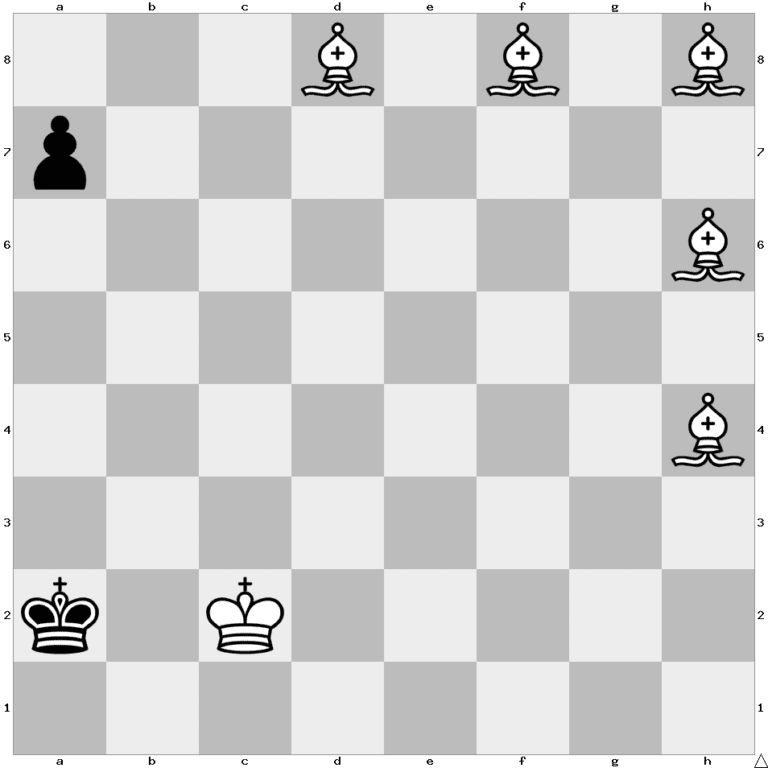Spelling Bees and Feet
Researchers have discovered
Older students have bigger feet and perform better at spelling bee contests.
We do not know where this puzzle originated from. If you have any information, please let us know via email.
Researchers have discovered
Older students have bigger feet and perform better at spelling bee contests.
James sent this beautiful photo to a contest, hoping he will win first prize. The contest organizers
Source: Puzzling StackExchange
There are stars over the moon, which is impossible.
What numbers should you put on the sides of two cubes, so that every date of the month can be expressed using these cubes?

You put the numbers 0, 1, 2, 3, 4, 5 on the first die and the numbers 0, 1, 2, 7, 8, 6/9 on the second die.
When do the hour and the minute hands of the clock lie on top of each other, and also between the numbers 1 and 2?
One such time is around 1:05 – at 1 o’clock and 5.454… minutes. This can be easily found by solving the linear equation x = 12(x – 5) => x=60/11.
Another time you possibly didn’t think about is 12:00 o’clock. At that time, the hour and minute hands are on top of each other and just between the two digits of the number 12.
There are four days which start with the letter “T” – Tuesday, Thursday, and which two others?
“Today” and “tomorrow”.
John gets off work at random times between 3 and 5 PM. His mother lives uptown, his girlfriend lives downtown. John takes the first subway that comes in either direction and eats dinner with the one he is delivered to. Even though John believes he has 50-50 chance to have dinner with either his mother or his girlfriend, he visited the former only 2 times out of the last 20. How come?
The subway heading downtown arrives at 3:00, 3:10, 3:20, etc, and the subway heading uptown arrives at 3:01, 3:11, 3:21, etc. Thus, the chance that John goes to his girlfriend is about 90% (depending on train delays).
White to move and mate Black.

Coming soon.
It is well known how to split fairly a cake between two people – one of them cuts, the other one picks. The question is, how can you split fairly a cake between three people?
Easy: “Fairly” means that every person gets at least 1/3 of the cake.
Hard: “Fairly” means that every person has the opportunity to get at least as much
Easy (Banach-Knaster method):
The first person cuts 1/3 piece of the cake. If the second person thinks it is larger than 1/3, he can trim it to 1/3. If the third person thinks the cut (and possibly trimmed) piece is larger than 1/3, he can trim it to 1/3 and keep it. Otherwise, the second person takes the piece if he decided to trim it, or the first one, in case he did not. After that, there are two people left, and they can easily split the remaining cake between them. This approach works for any number of people.
Hard (Selfridge-Conway method):
The first person cuts the cake in 3 pieces. The second one takes the biggest piece and trims it so that it becomes as large as the second biggest piece, puts the trimmings aside. The third person picks one of the three big pieces. Then, if the trimmed piece is still available, the second person takes it, if not – he picks whichever he likes. The first person takes the last remaining big piece. Among the first two people, whoever did not pick the trimmed big piece, splits the trimmings
You have two solid cubes of lead, which have almost the same size. You cut a hole in one of them and pass the other one through it. After measuring the cubes later, it turns out that the larger cube is still heavier than the smaller one. How is this possible?

You cut a hole in the SMALLER cube, and pass the larger cube through it. “Prince Rupert’s cube” is the largest cube which can pass through a unit cube, and it is approximately 6% larger.
Please confirm you want to block this member.
You will no longer be able to:
Please allow a few minutes for this process to complete.